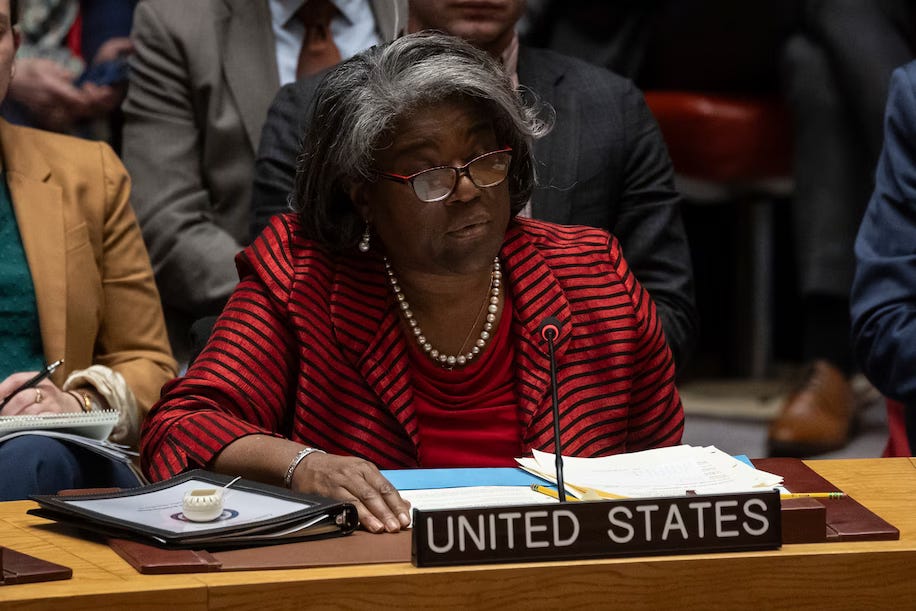U.N. Security Council Resolution on Israel-Hamas Conflict: Our Analysis
Security Council's Friday resolution calls for “urgent and extended humanitarian pauses” in fighting to allow for flow of humanitarian aid to Gaza, but does not demand a full and immediate cease-fire.
Introduction:
The United Nations Security Council (UNSC) adopted a pivotal resolution on the evening of Friday, December 23, endorsing "urgent and extended humanitarian pauses" in the ongoing Israel-Hamas conflict. This resolution offers a beacon of hope for de-escalating hostilities through concerted multilateral efforts. Conceived against a backdrop of unceasing artillery barrages and deep human anguish, its foremost goal is to ensure a consistent flow of humanitarian aid to the embattled Gaza populace. While representing a meaningful stride in diplomatic engagement to quell the persistent violence, the resolution conspicuously refrains from calling for an outright and comprehensive ceasefire.
The vote, carried by a significant majority of 13-0 with crucial abstentions from international heavyweights like the United States and Russia, underscores the complex geopolitical dynamics at play. This brief exploration seeks to dissect the nuanced elements of this latest UNSC resolution, shedding light on its stipulations, the diverse responses it has garnered, and its prospective impact on the region's fraught landscape.
The UNSC Resolution: An Evocative Plea for Peace
United Arab Emirates Ambassador Lana Nusseibeh described the resolution as "the Christmas miracle we were all hoping for," reflecting the international community's earnest desire to send a signal of hope to the people of Gaza. This resolution, calling for "urgent and extended humanitarian pauses," represents a diplomatic plea for a temporary halt in the conflict to allow critical aid to reach the beleaguered residents of Gaza. The passage of this resolution was the culmination of intense diplomacy led by the United States, the UAE, and other Arab nations. Despite its unanimous approval, the abstentions from significant players like the USA and Russia underscore the contentious and complex nature of the conflict.
The resolution's reluctance to mandate a full and immediate ceasefire continues to be a pivotal point of contention among the stakeholders, underscoring the enduring challenges within a framework where a veto by any one of the five permanent members can stymie any resolution. This aspect highlights the delicate balance and the intricate diplomatic negotiations inherent in the United Nations Security Council's decision-making process.
Dissecting the Vote: Understanding the Stances of USA and Russia
The abstentions by the United States and Russia significantly illuminate the intricate geopolitical dynamics in play. The United States' choice to abstain, rather than outright support or veto the resolution, indicates a strategic balance between its global interests and adherence to international humanitarian norms. Ambassador Linda Thomas-Greenfield articulated a sense of relief and resolve, underlining the resolution's vital role in mitigating the humanitarian crisis and fostering peace. Conversely, Russia's abstention, along with Ambassador Vassily Nebenzia's disparagement of the resolution as "entirely toothless," highlights its own strategic calculations. Nebenzia noted that Russia would have exercised its veto power had the resolution not garnered backing from several Arab nations, reflecting the complex interplay of diplomatic support and opposition within the Security Council.
Israel, Palestine and Hamas Respond to UNSC Resolution
Ambassador Riyad Mansour, the Palestinian U.N. envoy, lamented the prolonged 75 days it took for the Security Council to articulate a 'cessation of hostilities', highlighting the united support from Palestinian and Arab nations for the Russian amendment. He characterized the resolution as a positive step towards addressing urgent humanitarian needs but emphasized the necessity for its rigorous implementation and the critical need for intensified efforts towards an immediate ceasefire.
Conversely, Hamas denounced the resolution as inadequate, asserting that it fails to address the severity of the crisis exacerbated by the ongoing conflict in Gaza. They accused the United States of obstructing a definitive end to hostilities, thereby defying the wider international community's will.
On the Israeli side, the U.N. Deputy Ambassador Brett Jonathan Miller and Ambassador Gilad Erdan voiced their criticisms. Miller reproached the Security Council for not specifically condemning Hamas's actions, referring to the devastating impacts of the October 7 attacks, while Erdan through a social media post, conveyed skepticism about the resolution's efficacy and perceived impartiality. Collectively, these stances from Palestine, Hamas, and Israel underscore the profound mistrust and the stark divisions defining the conflict, complicating the path to a sustainable and peaceful resolution.
The stark reality of the conflict's toll was underscored by the grim statistics released by the Gaza Health Ministry, reporting at least 20,057 fatalities and 53,320 injuries since the conflict's escalation. The poignant narrative of personal loss was brought into focus with the tragic account of the Ministry of Health Director Mounir al-Bursh, whose 13-year-old daughter was among the casualties of a recent strike. Israel, too, faced severe losses, with about 1,200 fatalities reported following a surprise attack by Hamas on October 7. This date resonates with historical significance, marking exactly 50 years since the 1973 Yom Kippur War, reminding us of the enduring and cyclical nature of conflict in the region. These figures not only quantify the conflict's devastating impact but also emphasize the urgent need for effective and compassionate international intervention to prevent further loss of life and suffering.
Understanding the Earlier UN General Assembly Vote
Earlier, the UN General Assembly's vote reflected a more overwhelming consensus against the conflict's escalation. However, the UNSC's resolution, with its more specific focus and binding nature, carries a different weight. The transition from the General Assembly's broader condemnation to the Security Council's targeted plea marks an evolution in the international community's response to the crisis.
Our Perspective: Analyzing the Resolution's Impact
The resolution represents a notable shift from its predecessors, breaking away from the typical pattern of vetoes and deadlocks that often stymie the United Nations Security Council's efforts. It marks a cautious yet significant stride toward addressing the ongoing humanitarian crisis, demonstrating the international community's heightened urgency to mitigate the strife. While falling short of demanding a full ceasefire, the resolution's adoption underscores a collective impatience with the protracted conflict and an earnest desire to facilitate humanitarian aid. This development, however, came with the dilution of its more assertive demands. Instead of an urgent suspension of hostilities, the resolution now calls for immediate, albeit undefined, steps to ensure safe and expanded humanitarian access and lays the groundwork for a sustainable end to the fighting.
Language and Implications of the Resolution
The resolution's carefully crafted language reveals the subtleties of international diplomacy, avoiding unequivocal mandates or robust enforcement mechanisms. This moderated approach, while attracting criticism for its perceived leniency, reflects the intricate process of achieving consensus among diverse nations. The resolution's language is molded by the realities of global politics, attempting to harmonize the call for immediate humanitarian action with the pragmatic steps necessary for its realization. Notably, the resolution pivots from an exclusive United Nations oversight of aid deliveries to a more inclusive mechanism. It calls on the UN Secretary-General to appoint a coordinator to oversee and expedite the delivery of humanitarian aid, ensuring that all assistance is genuinely intended for relief efforts. This coordinator is tasked with establishing a mechanism to streamline aid delivery and requires the cooperation of all parties, including Israel and Hamas, to facilitate this process. Through these nuanced but critical adjustments, the resolution aims to navigate the complex dynamics of the conflict while prioritizing urgent humanitarian needs and setting a precedent for future diplomatic endeavors.
Conclusion: The Way Forward
The latest UNSC resolution reflects the global community's complex stance towards the Israel-Hamas conflict, embodying a sense of urgency, a degree of caution, and an acknowledgment of deep divisions. Although it may not immediately halt the fighting, this resolution represents a meaningful diplomatic effort, focusing on humanitarian relief and advocating for a measure of peace. As a modest yet hopeful step, it aims to alleviate the widespread suffering and establish a framework for more assertive future international actions. The timing of this resolution, coinciding nearly with Christmas Eve, symbolizes a crucial moment of compromise and necessity, fostering aspirations for more decisive and effective future agreements that could eventually lead to enduring peace in the region.




